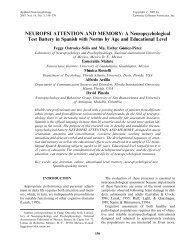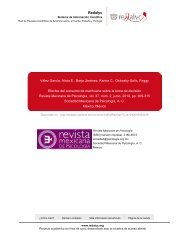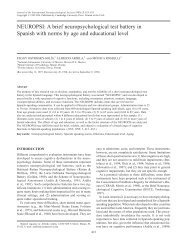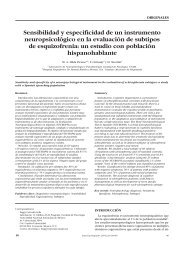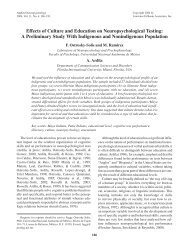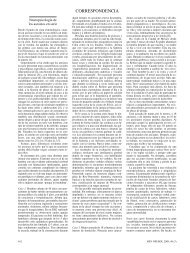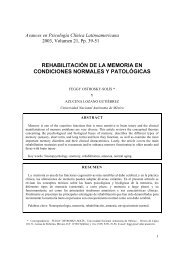Sensitivity and Specificity of the Mini-Mental State Examination in a ...
Sensitivity and Specificity of the Mini-Mental State Examination in a ...
Sensitivity and Specificity of the Mini-Mental State Examination in a ...
Create successful ePaper yourself
Turn your PDF publications into a flip-book with our unique Google optimized e-Paper software.
Applied NeuropsychologyCopyright 2000 by2000, Vol. 7, No. 1, 25–31 Lawrence Erlbaum Associates, Inc.<strong>Sensitivity</strong> <strong>and</strong> <strong>Specificity</strong> <strong>of</strong> <strong>the</strong> <strong>M<strong>in</strong>i</strong>-<strong>Mental</strong> <strong>State</strong> <strong>Exam<strong>in</strong>ation</strong> <strong>in</strong> aSpanish-Speak<strong>in</strong>g PopulationOSTROSKY-SOLÍS, SENSITIVITY LÓPEZ-ARANGO, & SPECIFICITY & ARDILAFeggy Ostrosky-Solís, Gabriela López-Arango, <strong>and</strong> Alfredo ArdilaDepartment <strong>of</strong> Psychophysiology, National Autonomous University <strong>of</strong> Mexico,Mexico City, MexicoThe <strong>M<strong>in</strong>i</strong>-<strong>Mental</strong> <strong>State</strong> <strong>Exam<strong>in</strong>ation</strong> (MMSE; Folste<strong>in</strong>, Folste<strong>in</strong>, & McHugh, 1975) was givento a total <strong>of</strong> 430 normal participants divided <strong>in</strong>to 3 age ranges (16–50, 51–65, <strong>and</strong> 66–89) <strong>and</strong> 4educational ranges (0, 1–4, 5–9, <strong>and</strong> ≥ 10 years). The educational level effect was notoriouslystronger than <strong>the</strong> age effect. Normal illiterate participants obta<strong>in</strong>ed scores that would correspondto severe cognitive alterations (M = 17.67); low education participants (1–4 years)would be classified with moderate cognitive alterations (M = 20.61). <strong>Sensitivity</strong> <strong>and</strong> specificity<strong>of</strong> <strong>the</strong> MMSE were established. Low sensitivity <strong>and</strong> specificity were found for both <strong>the</strong> participantswith 0 <strong>and</strong> 1 to 4 years <strong>of</strong> school<strong>in</strong>g, 50% <strong>and</strong> 72.73%, respectively. In participants withmore than 5 years <strong>of</strong> school<strong>in</strong>g, <strong>the</strong> specificity (86.36%) <strong>and</strong> sensitivity (86.36%) <strong>in</strong>dexes werehigher. We concluded that <strong>the</strong> MMSE is an <strong>in</strong>strument with little diagnostic utility among participantswith a low level <strong>of</strong> education.Key words: MMSE, neuropsychology, Spanish-speak<strong>in</strong>g participants, education effectThe <strong>M<strong>in</strong>i</strong>-<strong>Mental</strong> <strong>State</strong> <strong>Exam<strong>in</strong>ation</strong> (MMSE), publishedby Folste<strong>in</strong>, Folste<strong>in</strong>, <strong>and</strong> McHugh (1975), isone <strong>of</strong> <strong>the</strong> most frequently used rat<strong>in</strong>g <strong>in</strong>struments <strong>in</strong><strong>the</strong> evaluation <strong>of</strong> <strong>the</strong> mental state <strong>in</strong> both cl<strong>in</strong>ical practice<strong>and</strong> research (Crum, Anthony, Bassett, &Folste<strong>in</strong>, 1993). It was designed to quantify <strong>the</strong> degree<strong>of</strong> dementia <strong>and</strong> delirium <strong>in</strong> psychiatric <strong>and</strong> neurologicalpatients. It consists <strong>of</strong> short <strong>and</strong> simple items thatpermit a rapid evaluation <strong>of</strong> various cognitive doma<strong>in</strong>s,<strong>in</strong>clud<strong>in</strong>g orientation, encod<strong>in</strong>g, attention, recall,language, read<strong>in</strong>g, writ<strong>in</strong>g, <strong>and</strong> draw<strong>in</strong>g. Thescale has 11 items that add up to 30 po<strong>in</strong>ts. It requires5 to 10 m<strong>in</strong> for application, <strong>and</strong> when its ease <strong>and</strong>rapid adm<strong>in</strong>istration are taken <strong>in</strong>to consideration, ithas been widely used to detect cognitive alterations <strong>in</strong>populations classified as neurological, psychiatric,<strong>and</strong> geriatric (Lezak, 1995); to evaluate responses topharmacological treatment (Chatellier & Lancomblez,This project was partially supported by PAPITT (Programa deapoyo a proyectos de <strong>in</strong>vestigación y de <strong>in</strong>ovación tecnológica),Universidad Nacional Autónoma de México (IN300397).Requests for repr<strong>in</strong>ts should be sent to Feggy Ostrosky-Solís,Departamento Psic<strong>of</strong>isiología, Facultad de Psicología, Rivera deCupia #110–71 Lomas de Reforma, México D.F., México 11930.E-mail: feggy@servidor.unam.mx1990); as part <strong>of</strong> wider batteries, such as <strong>the</strong> Consortiumto Establish a Record <strong>of</strong> Alzheimer’s Disease(Morris et al., 1989); <strong>and</strong> as a screen<strong>in</strong>g <strong>in</strong>strument <strong>in</strong>both population <strong>and</strong> epidemiological studies for <strong>the</strong>detection <strong>of</strong> dementia (George, L<strong>and</strong>erman, Blazer, &Anthony, 1991; Li et al., 1980; Rovner, Kafonek,Flipp, & Folste<strong>in</strong>, 1990).In <strong>the</strong> orig<strong>in</strong>al st<strong>and</strong>ardization with 63 normal participantsover age 55, Folste<strong>in</strong> et al. (1975) reported aperformance range between 24 <strong>and</strong> 30 po<strong>in</strong>ts. Severalstudies (Anthony, LeResche, Niaz, von Korff, &Folste<strong>in</strong>, 1982; DePaulo, Folste<strong>in</strong>, & Gordon, 1980;Dick et al., 1984) suggest an optimum cut<strong>of</strong>f po<strong>in</strong>t <strong>of</strong>23/24 to separate patients with cognitive impairmentfrom those who are cognitively <strong>in</strong>tact. Us<strong>in</strong>g a cut<strong>of</strong>fpo<strong>in</strong>t <strong>of</strong> 23 <strong>and</strong> <strong>the</strong> psychiatric criterion, 87% sensitivity<strong>and</strong> 82% specificity have been reported (Folste<strong>in</strong>et al., 1975). Never<strong>the</strong>less, subsequent studies haveonly reported 63% sensitivity for <strong>the</strong> participants with8 years <strong>of</strong> school<strong>in</strong>g or less <strong>and</strong> only 65.5% sensitivityfor participants older than 60 (Anthony et al.,1982).The MMSE has been translated <strong>in</strong>to Spanish, <strong>and</strong> itsusefulness has been evaluated <strong>in</strong> cross-cultural studies(Bertolucci, Brucki, Campacci, & Juliano, 1994; Bird,Can<strong>in</strong>o, Rubio, & Shrout, 1987; Escobar et al., 1986).25
SENSITIVITY & SPECIFICITYTable 1.Total Sample: Means <strong>and</strong> St<strong>and</strong>ard Deviations by Age <strong>and</strong> Years <strong>of</strong> SchoolAge (Years)16–50 51–65 66–89Age Years <strong>of</strong> School Age Years <strong>of</strong> School Age Years <strong>of</strong> SchoolYears <strong>of</strong> School M SD M SD M SD M SD M SD M SDZero 40.0 9.35 0.0 0.0 59.5 2.74 0.0 0.00 72.2 4.56 0.0 0.001–4 28.6 9.60 2.9 1.04 58.5 3.83 2.2 .95 73.6 6.12 2.5 1.255–9 33.4 10.98 8.4 1.21 59.9 3.18 7.1 1.53 73.3 5.63 7.6 1.36≥10 27.5 7.74 14.9 3.04 57.9 3.23 15.7 3.85 73.0 4.71 13.1 2.60Note: N = 430Table 2. Matched Samples: Means <strong>and</strong> St<strong>and</strong>ard Deviations <strong>of</strong>Age <strong>and</strong> Years <strong>of</strong> SchoolMaterialCurrently <strong>in</strong> Mexico City, <strong>the</strong>re are several translations<strong>of</strong> <strong>the</strong> MMSE. After <strong>in</strong>terview<strong>in</strong>g 10 cl<strong>in</strong>icians,we selected <strong>the</strong> version used by 6 <strong>of</strong> <strong>the</strong>m (see Appendix).It was found that some <strong>of</strong> <strong>the</strong> questions wereadapted to <strong>the</strong> characteristics <strong>of</strong> <strong>the</strong> Spanish-speak<strong>in</strong>gpopulation. For example, <strong>the</strong> orig<strong>in</strong>al item “What are<strong>the</strong> four seasons <strong>of</strong> <strong>the</strong> year?” had been removed. Theseasons <strong>of</strong> <strong>the</strong> year are not relevant for orientation <strong>in</strong>tropical <strong>and</strong> subtropical Spanish-speak<strong>in</strong>g countrieswhere <strong>the</strong> dry <strong>and</strong> ra<strong>in</strong>y seasons are more relevant climaticdifferences. The orig<strong>in</strong>al phrase had been substitutedby “No iré si tu no llegas temprano” (“I won’t goif you don’t arrive early”). The total MMSE score wasobta<strong>in</strong>ed by add<strong>in</strong>g up <strong>the</strong> correct answers.Statistical AnalysisAge (Years)Years <strong>of</strong> SchoolGroup n M SD M SDControl 40 73.10 6.99 7.28 4.65Dementia 40 74.15 8.17 7.00 4.65Analyses <strong>of</strong> variance (ANOVAs) were used to analyzeage <strong>and</strong> education effects. A significance <strong>of</strong> p
OSTROSKY-SOLÍS, LÓPEZ-ARANGO, & ARDILATable 3.Means <strong>and</strong> St<strong>and</strong>ard Deviations <strong>in</strong> <strong>the</strong> MMSE <strong>in</strong> <strong>the</strong> Total SampleAge (Years)16–50 51–65 66–89Years <strong>of</strong> School M SD M SD M SDZero 19.75 3.69 16.88 4.44 16.38 4.271–4 19.14 3.99 21.10 4.49 21.59 4.855–9 26.27 1.95 27.74 1.92 25.52 2.65≥ 10 27.93 1.96 28.27 1.83 26.34 3.90Note: N = 430. MMSE = <strong>M<strong>in</strong>i</strong>-<strong>Mental</strong> <strong>State</strong> <strong>Exam<strong>in</strong>ation</strong> (Folste<strong>in</strong>, Folste<strong>in</strong>, & McHugh, 1975).with <strong>in</strong>creased age. This association between age <strong>and</strong>education is illustrated <strong>in</strong> Figure 1.When <strong>the</strong> average performance <strong>of</strong> <strong>the</strong> MMSE score<strong>of</strong> <strong>the</strong> matched samples was obta<strong>in</strong>ed, we noted that <strong>the</strong>normal sample had an average <strong>of</strong> 25.37, whereas <strong>the</strong>average for <strong>the</strong> participants with dementia was 18.33.When education was not considered <strong>and</strong> when we used<strong>the</strong> cut<strong>of</strong>f po<strong>in</strong>t <strong>of</strong> 23/24 recommended for participantsolder than 60 (Anthony et al., 1982), we obta<strong>in</strong>ed values<strong>of</strong> 80% sensitivity <strong>and</strong> 77.5% specificity. When <strong>the</strong>sample was divided by school<strong>in</strong>g, acceptable sensitivity<strong>and</strong> specificity was found only for people with morethan 5 years <strong>of</strong> education. However, when we used <strong>the</strong>same cut<strong>of</strong>f po<strong>in</strong>t for persons with lower education, wefound a considerable reduction <strong>in</strong> specificity. These resultsare presented <strong>in</strong> Table 4.Some authors (Mungas et al., 1996) have proposed<strong>the</strong> use <strong>of</strong> different cut<strong>of</strong>f po<strong>in</strong>ts depend<strong>in</strong>g on <strong>the</strong> level<strong>of</strong> education. Tak<strong>in</strong>g this proposal, we aga<strong>in</strong> obta<strong>in</strong>ed<strong>the</strong> sensitivity <strong>and</strong> specificity <strong>in</strong>dexes, adjust<strong>in</strong>g <strong>the</strong>cut<strong>of</strong>f po<strong>in</strong>t accord<strong>in</strong>g to <strong>the</strong> performance <strong>of</strong> <strong>the</strong> firsttwo subgroups. When we used <strong>the</strong> average obta<strong>in</strong>ed byeach group as <strong>the</strong> cut<strong>of</strong>f po<strong>in</strong>t (Ms = 17 <strong>and</strong> 20 for 0Figure 1. <strong>M<strong>in</strong>i</strong>-<strong>Mental</strong> <strong>State</strong> <strong>Exam<strong>in</strong>ation</strong> (MMSE) scores <strong>in</strong><strong>the</strong> different age <strong>and</strong> education groups.Table 4. <strong>Sensitivity</strong> <strong>and</strong> <strong>Specificity</strong> <strong>of</strong> <strong>the</strong> MMSE Accord<strong>in</strong>g toEducational Levelyears <strong>and</strong> 1–4 years <strong>of</strong> school<strong>in</strong>g, respectively), we obta<strong>in</strong>ed18.18% sensitivity <strong>and</strong> 90% specificity for <strong>the</strong>first educational group, whereas we found 27.27% sensitivity<strong>and</strong> 90% specificity for <strong>the</strong> second group.DiscussionYears <strong>of</strong> School0–4 5–9 ≥ 10<strong>Specificity</strong> .50 .86 .87<strong>Sensitivity</strong> .73 .86 .71Note: MMSE = <strong>M<strong>in</strong>i</strong>-<strong>Mental</strong> <strong>State</strong> <strong>Exam<strong>in</strong>ation</strong> (Folste<strong>in</strong>, Folste<strong>in</strong>,& McHugh, 1975).Our results showed that <strong>the</strong> level <strong>of</strong> school<strong>in</strong>g plays avery significant role <strong>in</strong> <strong>the</strong> MMSE total score. The performance<strong>of</strong> <strong>in</strong>dividuals with no school<strong>in</strong>g was as low asthat <strong>of</strong> participants with severe dementia, whereas <strong>the</strong>score for those with 1 to 4 years <strong>of</strong> school<strong>in</strong>g was similarto that <strong>of</strong> participants with mild dementia.The <strong>in</strong>teraction between age <strong>and</strong> school<strong>in</strong>g wasma<strong>in</strong>ly noted <strong>in</strong> participants with no education or limitededucation. The MMSE performance level <strong>in</strong> <strong>the</strong>group <strong>of</strong> illiterate persons dropped as age <strong>in</strong>creased,whereas <strong>the</strong> population with 1 year <strong>of</strong> school<strong>in</strong>g ormore did not show significant changes associated withage.With a cut<strong>of</strong>f po<strong>in</strong>t <strong>of</strong> 23/24, <strong>the</strong> sensitivity <strong>and</strong>specificity were acceptable (80% <strong>and</strong> 77.5%, respectively),provided that <strong>the</strong> school<strong>in</strong>g factor was not <strong>in</strong>cluded.However, when <strong>the</strong> sample was broken down<strong>in</strong>to various school<strong>in</strong>g levels, a marked decl<strong>in</strong>e <strong>in</strong> <strong>the</strong>specificity among persons with no school<strong>in</strong>g or 1 to 4years <strong>of</strong> school<strong>in</strong>g was noted (50%). Although <strong>the</strong> ad-28
SENSITIVITY & SPECIFICITYjustment <strong>of</strong> <strong>the</strong> cut<strong>of</strong>f po<strong>in</strong>t for <strong>the</strong> population with 0 to4 years <strong>of</strong> school<strong>in</strong>g <strong>in</strong> terms <strong>of</strong> average performance(17 for <strong>the</strong> illiterate <strong>and</strong> 20 for those with 1 to 4 years <strong>of</strong>school<strong>in</strong>g) produced a significant <strong>in</strong>crease <strong>in</strong> specificity(adequate discrim<strong>in</strong>ation <strong>of</strong> <strong>in</strong>dividuals without pathology),sensitivity decl<strong>in</strong>ed significantly (detection<strong>of</strong> <strong>in</strong>dividuals with cognitive deterioration). Thus, weconclude that vary<strong>in</strong>g <strong>the</strong> cut<strong>of</strong>f po<strong>in</strong>t is not sufficientto obta<strong>in</strong> adequate sensitivity <strong>and</strong> specificity <strong>in</strong>dexesbecause one is favored to <strong>the</strong> detriment <strong>of</strong> <strong>the</strong> o<strong>the</strong>r.Recently, Crum et al. (1993) reported <strong>the</strong> distribution<strong>of</strong> MMSE scores by age <strong>and</strong> education <strong>in</strong> a population<strong>of</strong> 18,056 <strong>in</strong>dividuals <strong>in</strong> five U.S. cities (NewHaven, CT; Baltimore; St. Louis, MO; Durham, NC;<strong>and</strong> Los Angeles). The MMSE scores were related toage <strong>and</strong> school<strong>in</strong>g level. They found an <strong>in</strong>verse relationbetween MMSE scores <strong>and</strong> age, with a mean <strong>of</strong> 29 forthose 18 to 24 years <strong>of</strong> age <strong>and</strong> 25 for <strong>in</strong>dividuals 80years <strong>of</strong> age. The mean was 29 for <strong>in</strong>dividuals withmore than 9 years <strong>of</strong> school<strong>in</strong>g, 26 for those with 5 to 8years <strong>of</strong> school<strong>in</strong>g, <strong>and</strong> 22 for those with 0 to 4 years <strong>of</strong>school<strong>in</strong>g. In <strong>the</strong> Crum et al. study, two changes weremade to <strong>the</strong> orig<strong>in</strong>al version. Instead <strong>of</strong> ask<strong>in</strong>g <strong>the</strong> participantsabout <strong>the</strong> country <strong>the</strong>y were <strong>in</strong>, <strong>the</strong>y asked for<strong>the</strong> names <strong>of</strong> two major thoroughfares nearby. To obta<strong>in</strong>total scores, <strong>the</strong>y used <strong>the</strong> highest score <strong>in</strong> <strong>the</strong> answersto successive subtraction items (100 – 7) or <strong>the</strong>reversed spell<strong>in</strong>g <strong>of</strong> world. Us<strong>in</strong>g <strong>the</strong> score on <strong>the</strong>seitems can affect <strong>the</strong> total grade because each item contributes5 po<strong>in</strong>ts to <strong>the</strong> f<strong>in</strong>al score. Alterations <strong>of</strong> thisk<strong>in</strong>d may mean that <strong>the</strong> results are not comparable witho<strong>the</strong>r studies, although <strong>the</strong>se results roughly supportour f<strong>in</strong>d<strong>in</strong>gs.Our f<strong>in</strong>d<strong>in</strong>gs co<strong>in</strong>cide with o<strong>the</strong>r studies(Bertolucci et al.,1994; Bird et al., 1987; Escobar etal., 1986) that have also reported that <strong>the</strong> MMSEscore is sensitive to <strong>the</strong> participant’s school<strong>in</strong>g level<strong>and</strong> cultural background. As <strong>in</strong> our study, <strong>the</strong> itemsthat were most sensitive to educational level werethose that <strong>in</strong>volve read<strong>in</strong>g, writ<strong>in</strong>g, <strong>and</strong> calculation,whereas cultural factors affect <strong>the</strong> answers referr<strong>in</strong>g toseasons <strong>of</strong> <strong>the</strong> year <strong>and</strong> <strong>the</strong> concept <strong>of</strong> <strong>the</strong> state. Theconcepts <strong>of</strong> state may be confus<strong>in</strong>g for someone whois not used to this term.The specificity <strong>of</strong> <strong>the</strong> test was particularly lowamong participants with a low school<strong>in</strong>g level (0–4years) when compared to those with 5 to 9 years <strong>of</strong>school<strong>in</strong>g (50% vs. 86%). This f<strong>in</strong>d<strong>in</strong>g has significantimplications for both research <strong>and</strong> cl<strong>in</strong>ical practice.Epidemiological studies that only <strong>in</strong>clude <strong>the</strong> MMSEas a rat<strong>in</strong>g <strong>in</strong>strument will classify normal participantswith low school<strong>in</strong>g as pathological <strong>in</strong>dividuals. Likeo<strong>the</strong>r screen<strong>in</strong>g scales, <strong>the</strong> MMSE may be useful <strong>in</strong>monitor<strong>in</strong>g changes associated with pharmacologicaltreatment or o<strong>the</strong>r types <strong>of</strong> <strong>in</strong>tervention but not for diagnosispurposes. In cl<strong>in</strong>ical practice, it is necessaryto use <strong>in</strong>struments that permit early detection <strong>of</strong> cognitivealternations <strong>in</strong> <strong>the</strong> diagnosis <strong>of</strong> dementia symptoms.This detection becomes especially relevant <strong>in</strong><strong>the</strong> cases <strong>of</strong> treatable or partially treatable dementia,which require an early diagnosis (Ostrosky-Solís etal., 1996).Ano<strong>the</strong>r criticism <strong>of</strong> screen<strong>in</strong>g <strong>in</strong>struments like <strong>the</strong>MMSE is <strong>the</strong> high percentage <strong>of</strong> false negatives, for example,<strong>the</strong> lack <strong>of</strong> sensitivity to slight cognitive disorders(Nelson, Fooel, & Faust, 1986). This problem isparticularly apparent <strong>in</strong> patients with high levels <strong>of</strong>premorbid <strong>in</strong>telligence. In our sample, <strong>the</strong> ability to detectparticipants with a dementia diagnosis with 10 ormore years <strong>of</strong> school<strong>in</strong>g was 71.43%.In conclusion, <strong>the</strong> MMSE may be helpful for confirm<strong>in</strong>g<strong>the</strong> presence <strong>of</strong> severe cognitive alterations <strong>in</strong>participants with more than 5 years <strong>of</strong> school<strong>in</strong>g, but itshould not be considered for <strong>the</strong> detection <strong>of</strong> slight cognitivedeterioration.ReferencesAmerican Psychiatric Association. (1994). Diagnostic <strong>and</strong> statisticalmanual <strong>of</strong> mental disorders (4th ed.). Wash<strong>in</strong>gton, DC: Author.Anthony, J. C., LeResche, L., Niaz, U., von Korff, M. R., & Folste<strong>in</strong>,M. E. (1982). Limits <strong>of</strong> <strong>the</strong> “<strong>M<strong>in</strong>i</strong>-<strong>Mental</strong> <strong>State</strong>” as a screen<strong>in</strong>gtest for dementia <strong>and</strong> delirium among hospital patients. PsychologicalMedic<strong>in</strong>e, 12, 397–408.Becerra, B., Ortega-Soto, H. A., & Torner, C. (1992). Validez yreproducibilidad del Examen Cognoscitivo Breve (<strong>M<strong>in</strong>i</strong>-<strong>Mental</strong><strong>State</strong> <strong>Exam<strong>in</strong>ation</strong>) en una unidad de cuidados especiales deun hospital psiquiátrico [Validity <strong>and</strong> reproducibility <strong>of</strong> <strong>the</strong><strong>M<strong>in</strong>i</strong>-<strong>Mental</strong> <strong>State</strong> <strong>Exam<strong>in</strong>ation</strong> <strong>in</strong> a special care unit <strong>of</strong> a psychiatrichospital]. Salud <strong>Mental</strong>, 15(4), 41–45.Bertolucci, P. H. F., Brucki, S., Campacci, S. R., & Juliano, Y.(1994). O <strong>M<strong>in</strong>i</strong>-Exame do Estado <strong>Mental</strong> em uma PopulaçãoGeral: Impacto da scolaridade [<strong>M<strong>in</strong>i</strong>-<strong>Mental</strong> <strong>State</strong> <strong>Exam<strong>in</strong>ation</strong><strong>in</strong> a general population: Effects <strong>of</strong> education]. Arquivos deNeuropsiquiatria, 52, 1–7.Bird, R. H., Can<strong>in</strong>o, G., Rubio, S. M., & Shrout, P. (1987). Use <strong>of</strong> <strong>the</strong><strong>M<strong>in</strong>i</strong>-<strong>Mental</strong> <strong>State</strong> <strong>Exam<strong>in</strong>ation</strong> <strong>in</strong> a probability sample <strong>of</strong> aHispanic population. Journal <strong>of</strong> Nervous <strong>and</strong> <strong>Mental</strong> Disease,175, 731–737.Chatellier, G., & Lancomblez, L. (1990). Tacr<strong>in</strong>e(tetra-H-hidroam<strong>in</strong>ocrid<strong>in</strong>e: THA) <strong>and</strong> lecith<strong>in</strong> <strong>in</strong> treatment <strong>of</strong>dementia <strong>of</strong> <strong>the</strong> Alzheimer’s type: A multicenter study. BritishMedical Journal, 300, 495–499.Crum, R. M., Anthony, J. C., Bassett, S. S., & Folste<strong>in</strong>, M. F. (1993).Population-based norms for <strong>the</strong> <strong>M<strong>in</strong>i</strong>-<strong>Mental</strong> <strong>State</strong> <strong>Exam<strong>in</strong>ation</strong>by age <strong>and</strong> educational level. Journal <strong>of</strong> <strong>the</strong> AmericanMedical Association, 269, 2386–2391.29
OSTROSKY-SOLÍS, LÓPEZ-ARANGO, & ARDILADePaulo, J. R., Folste<strong>in</strong>, M. F., & Gordon, B. (1980). Psychiatricscreen<strong>in</strong>g on a neurological ward. Psychological Medic<strong>in</strong>e, 10,125–132.Dick, J. P., Guil<strong>of</strong>f, R. J., Stewart, A., Blackstock, J., Bielawska, C.,Paul, E. A., & Marsden, C. D. (1984). <strong>M<strong>in</strong>i</strong>-<strong>Mental</strong> <strong>State</strong> <strong>Exam<strong>in</strong>ation</strong><strong>in</strong> neurological patients. Journal <strong>of</strong> Neurology, Neurosurgery<strong>and</strong> Psychiatry, 47, 496–499.Escobar, J. I., Burnam, A., Karno, M., Forsy<strong>the</strong>, A., L<strong>and</strong>sverk, J., &Gold<strong>in</strong>g, J. M. (1986). Use <strong>of</strong> <strong>the</strong> <strong>M<strong>in</strong>i</strong>-<strong>Mental</strong> <strong>State</strong> <strong>Exam<strong>in</strong>ation</strong>(MMSE) <strong>in</strong> a community population <strong>of</strong> mixed ethnicity.Journal <strong>of</strong> Nervous <strong>and</strong> <strong>Mental</strong> Disease, 174, 607–614.Fillenbaum, G., Heyman, A., Willians, K., Prosnitz, B., & Burchett,B. (1990). <strong>Sensitivity</strong> <strong>and</strong> specificity <strong>of</strong> st<strong>and</strong>ardized screens <strong>of</strong>cognitive impairment <strong>and</strong> dementia among elderly Blacks <strong>and</strong>White community residents. Journal <strong>of</strong> Cl<strong>in</strong>ical Epidemiology,43, 651–660.F<strong>in</strong>layson, N. A., Jonhson, K. A., & Reitan, R. M. (1977). Relation<strong>of</strong> level <strong>of</strong> education to neuropsychological measures <strong>in</strong> bra<strong>in</strong>damaged <strong>and</strong> non-bra<strong>in</strong> damaged adults. Journal <strong>of</strong> Consult<strong>in</strong>g<strong>and</strong> Cl<strong>in</strong>ical Psychology, 45, 536–542.Folste<strong>in</strong>, M. F., Folste<strong>in</strong>, S. E., & McHugh, P. R. (1975).<strong>M<strong>in</strong>i</strong>-<strong>Mental</strong> <strong>State</strong>: A practical method for grad<strong>in</strong>g <strong>the</strong> cognitivestate <strong>of</strong> patients for <strong>the</strong> cl<strong>in</strong>ician. Journal <strong>of</strong> PsychiatricResearch, 12, 189–198.George, L. K., L<strong>and</strong>erman, R., Blazer, D. G., & Anthony, J. C.(1991). Cognitive impairment. In L. N. Robb<strong>in</strong>s & D. A.Regier (Eds.), Psychiatric disorders at America: Theepidemiologic catchment area study (pp. 237–291). NewYork: Free Press.Gurl<strong>and</strong>, B. J., Wilder, D. E., Cross, P., Teresi, J., & Barrett, V. W.(1992). Screen<strong>in</strong>g scales for dementia: Toward reconciliation<strong>of</strong> conflict<strong>in</strong>g cross-cultural f<strong>in</strong>d<strong>in</strong>gs. International Journal <strong>of</strong>Geriatric Psychiatry, 7, 105–113.Hanley, J. A., & McNeil, B. J. (1982). The mean<strong>in</strong>g <strong>and</strong> use <strong>of</strong> <strong>the</strong>area under a receiver operat<strong>in</strong>g characteristic (ROC) curve. DiagnosticRadiology, 143, 29–36.Launer, L. J., D<strong>in</strong>kgreve, M. A., Jonker, C., Hooijer, C., &L<strong>in</strong>deboom, J. (1993). Are age <strong>and</strong> education <strong>in</strong>dependent correlates<strong>of</strong> <strong>the</strong> <strong>M<strong>in</strong>i</strong>-<strong>Mental</strong> <strong>State</strong> Exam performance <strong>of</strong> community-dwell<strong>in</strong>gelderly? Journal <strong>of</strong> Gerontology, 48, 271–277.Lezak, M. D. (1995). Neuropsychological assessment (3rd ed.).New York: Oxford University Press.Li, G., Shen, Y. C., Chen, C. H., Zhao, Y. W., Li, S. R., & Lu, M.(1980). An epidemiological survey <strong>of</strong> age-related dementia <strong>in</strong>an urban area <strong>of</strong> Beij<strong>in</strong>g. Acta Psychiatrica Sc<strong>and</strong><strong>in</strong>avica, 79,557–563.Morris, H. C., Heyman, A., Mohs, R. C., Hughes, J. P., Van Belle,G., Fillenbaum, G., Mellits, E. D., Clark, C., & Consortium toEstablish a Record <strong>of</strong> Alzheimer’s Disease Investigators.(1989). The Consortium to Establish a Registry for Alzheimer’sDisease (CERAD): Part 1. Cl<strong>in</strong>ical <strong>and</strong>neuropsychological assessment <strong>of</strong> Alzheimer’s disease. Neurology,39, 1159–1165.Mungas, D., Marshall, S. C., Weldon, M., Haan, M., & Reed, B. R.(1996). Age <strong>and</strong> education correction <strong>of</strong> <strong>M<strong>in</strong>i</strong>-<strong>Mental</strong> <strong>State</strong> <strong>Exam<strong>in</strong>ation</strong>for English <strong>and</strong> Spanish-speak<strong>in</strong>g elderly. Neurology,46, 700–706.Murden, R. A., McRae, T. D., Kaner, S., & Bucknam, M. E. (1991).<strong>M<strong>in</strong>i</strong>-<strong>Mental</strong> Status Exam scores with education <strong>in</strong> Blacks <strong>and</strong>Whites. Journal <strong>of</strong> <strong>the</strong> American Geriatrics Society, 43,138–145.Nelson, A., Fooel, B. S., & Faust, D. (1986). Bedside cognitivescreen<strong>in</strong>g <strong>in</strong>struments <strong>in</strong> critical assessment. Journal <strong>of</strong> Nervous<strong>and</strong> <strong>Mental</strong> Disease, 174, 73–83.Ostrosky, F., Canseco, E., Qu<strong>in</strong>tanar, L., Navarro, E., & Ardila, A.(1985). Sociocultural effects <strong>in</strong> neuropsychological assessment.International Journal <strong>of</strong> Neuroscience, 27, 53–66.Ostrosky, F., Qu<strong>in</strong>tanar, L., Canseco, E., Meneses, S., Navarro, E.,& Ardila, A. (1986). Actividad cognoscitiva y nivelsociocultural [Cognitive activity <strong>and</strong> sociocultural level].Revista de Investigación Clínica, 38, 37–42.Ostrosky-Solís, F., Ardila, A., & Chayo, R. (1996). Rehabilitaciónneuropsicológica [Neuropsychological rehabilitation]. MexicoCity, Mexico: Planeta.Pfeffer, R. J., Kurosaki, T. T., Harrah, C. H., Jr., Chance, J. M.,Bates, D., Detels, R., Filos, S., & Butzke, C. (1981). A surveydiagnostic tool for senile dementia. American Journal <strong>of</strong> Epidemiology,114, 515–527.Rovner, B. W., Kafonek, S., Filipp, L., & Folste<strong>in</strong>, M. P. (1990).Prevalence <strong>of</strong> mental illness <strong>in</strong> a community nurs<strong>in</strong>g home.American Journal <strong>of</strong> Psychiatry, 147, 1446–1449.Srivastav, P. K., Agarwal, K., & Kumar, S. (1989). Effects <strong>of</strong> education<strong>and</strong> sex on some common cl<strong>in</strong>ical tests used <strong>in</strong> mental statusexam<strong>in</strong>ations. Indian Journal <strong>of</strong> Psychiatry, 31, 134–138.Orig<strong>in</strong>al submission May 28, 1999Accepted September 8, 199930
SENSITIVITY & SPECIFICITYORIENTACIONAppendix:Examen <strong>Mental</strong> Breve (MMSE)1. Punto para cada una de las respuestas correctas.¿Qué hora es?. .........................( )¿Qué fecha es hoy? .....................( )¿Qué día de la semana es hoy? .............( )¿Qué mes? ............................( )¿Qué año? ............................( )Total 5 puntos ( )¿Cómo se llama este lugar? ...............( )¿En qué rumbo de la ciudad, colonia está? ....( )¿Ciudad? .............................( )¿País? ................................( )¿Norte, sur, poniente, etc? ................( )Total 5 puntos ( )REGISTRORepita el nombre de los 3 objetos que voy a decir,puntúe2ó1siéste es el número correcto que ha repetidoel paciente. Insista hasta que el paciente logre repetir los3 nombres ya que se valorará la EVOCACIÓN. Lápiz.Llave. Libro.Total 3 puntos ( )ATENCIÓN Y CÁLCULOPida al paciente que sustraiga 7 de 100 c<strong>in</strong>co veces,puntu<strong>and</strong>o una correcta por cada ocasión bien realizada.Total 5 puntos ( )LENGUAJE1 puntos por cada objeto bien nombrado: (reloj, lápiz).Total 2 puntos ( )1 punto si la siguiente oración es repetidacorrectamente.“NO IRÉ, SI TU NO LLEGAS TEMPRANO”Total 1 punto ( )1 punto por las 3 órdenes bien ejecutadas“Con el dedo derecho, toque la punta de su nariz yluego su oído izquierdo o tome este pedazo de papelcon su mano derecha, dóblelo y tírelo al suelo”Total 3 puntos ( )LECTURA1 punto por obedecer la orden escrita: “CIERRE SUSOJOS”Total 1 punto ( )ESCRITURA1 punto por escribir una oración que <strong>in</strong>cluya verbo ysujeto y tenga sentido.Total 1 punto ( )DIBUJO1 punto por la copia de 2 pentágonos (2 cm cada lado)<strong>in</strong>terceptados.Total 1 punto ( )EVOCACIÓNPida al paciente que repita las 3 palabras que se le dijo. 1punto por cada palabra correcta.Total 3 puntos ( )PUNTUACIÓN OBTENIDA _______31



